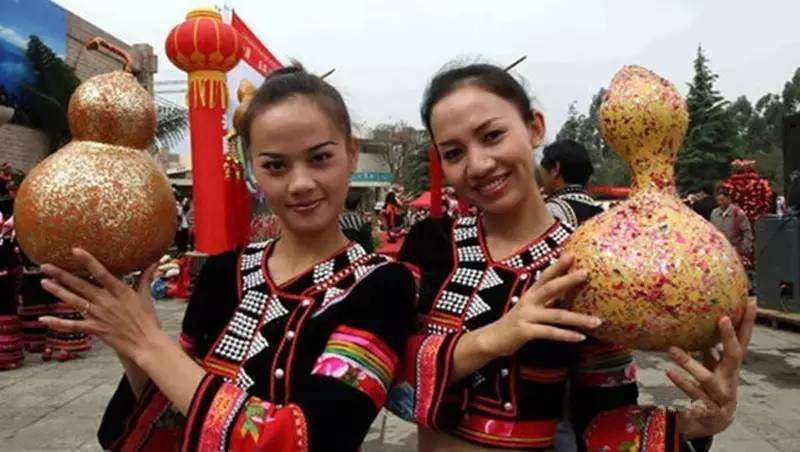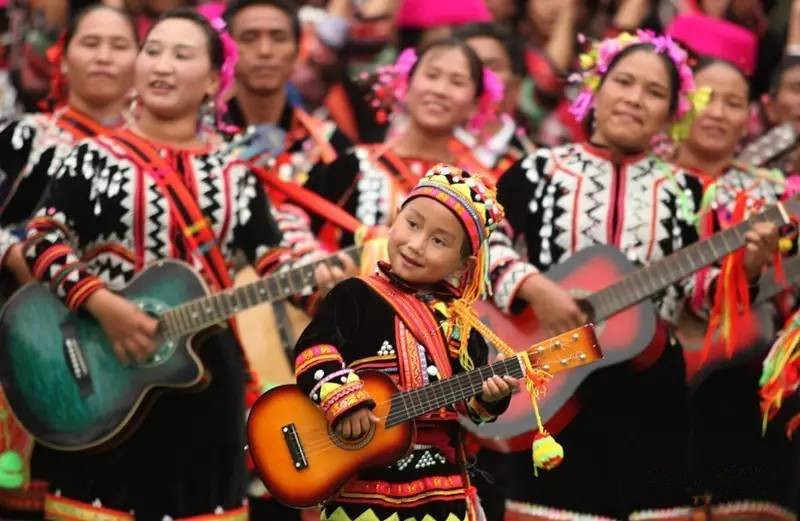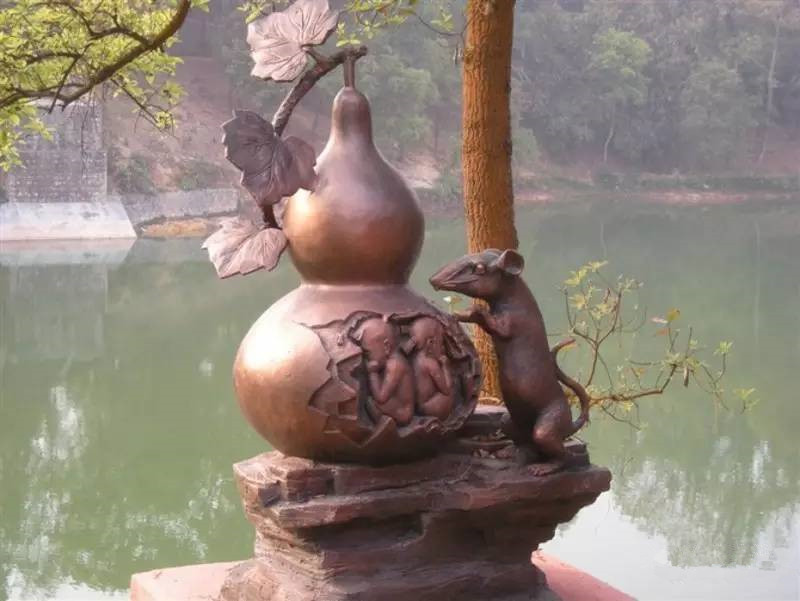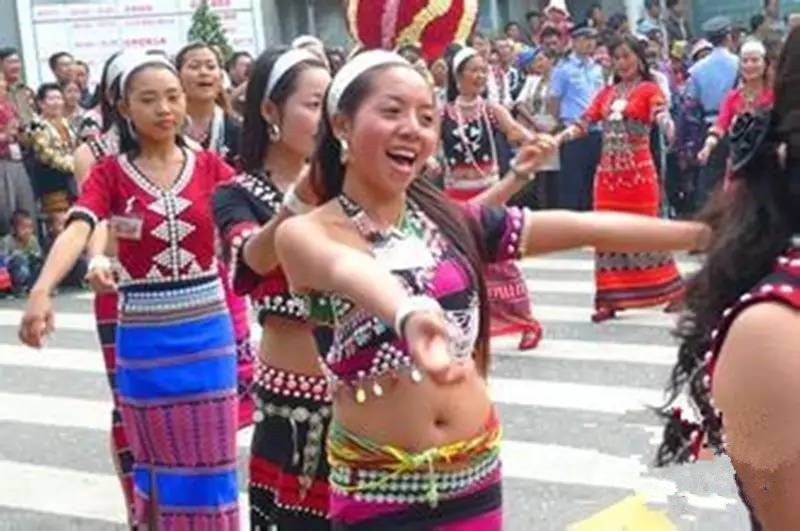
The Calabash Festival of Lahu Ethnic Minority in Lancang County, Puer
Chinese Name: 澜沧拉祜族葫芦节
English Name: Calabash (Hulu) Festival of Lahu Ethnic Minority in Lancang County, Puer
The Hulu Festival, known in Lahu language as “Apong Alongni,” is the most significant festival for the Lahu people in Lancang County. It is traditionally celebrated on the 15th day of the 10th lunar month, but since 2006, the festival dates have been adjusted to April 8, 9, and 10 in the Gregorian calendar. During the festival, every village holds grand celebrations with singing and dancing. Men play the lusheng (a traditional reed pipe instrument) while leading the dance, and both men and women participate in the “Gaka” dance. Women play the elephant-foot drum while performing the Bai dance, and young men and women engage in antiphonal singing of folk songs. Various sports and games, such as swing contests, water carrying, top-spinning, and crossbow shooting competitions, also take place. The elders gather around the hearth, drinking wine and reciting the creation epic “Mu Pa Mi Pa.” In the center of the dance ground, a pair of gourds is placed, symbolizing the ancestors of the Lahu people, reminding everyone to honor and remember their ancestors’ kindness.
Overview
Significance:
The Hulu Festival, known as “Apong Alongni” in the Lahu language, is celebrated annually on the 15th day of the 10th lunar month. Since 2006, the festival has been held on April 8, 9, and 10. On this day, the Lahu people dress in their vibrant traditional costumes, sing and dance, bring homemade wine and glutinous rice cakes, and gather in the village squares to begin the annual celebrations.
Activities:
Young people and elders play the lusheng, while girls perform joyful group dances. The dances vividly express the stages of life, from plowing the fields, sowing seeds, to the final joy of harvest, expressing gratitude for the sunshine, rain, and a prosperous year free of illness and disaster. At night, a bonfire is lit, and amidst the melodious music and deep drumbeats, elders share their life experiences through song—stories of their mothers’ labor, the challenges of growing up, marriage, leaving parents, raising children, and eventually aging. These sorrowful and beautiful tales are slowly revealed under the moonlight, accompanied by the flickering fire and the steady drumbeats, as if the river of life is flowing nearby, and the once-lost youthful years seem to flow again under the moonlight. For the next three days and nights, the Lahu people continue to sing and dance. When thirsty, they drink rice wine; when hungry, they eat rice cakes; and when tired, they rest. Others continue, using their voices, whether melodious or hoarse, to sing of the joys and sorrows of life, and using their bodies, whether young or old, to express reverence for the gourd, the sacred object that brought them life.
Legend
According to the Lahu creation epics “Mu Pa Mi Pa” and “Shuo Dian Lu Dian,” the Lahu people’s ancestors were created by the heavenly god “Esha” using a gourd on the 15th day of the 10th lunar month. Therefore, the Lahu people believe they are descendants of the gourd, viewing the gourd as an embodiment of their ancestors and a symbol of good fortune for the entire nation. This belief in the gourd reflects the Lahu people’s long-standing close relationship with nature and their survival struggles in the mountainous regions. The Hulu Festival is rich in ethnic characteristics and activities, making it a joyous occasion for the whole community, filled with cultural and historical significance. Every year, the Lancang County government organizes various cultural, sports, and commercial exchange activities during the festival, combining traditional ethnic celebrations with economic development to further enhance the festival’s social impact and recognition.
Origins
The Lahu people regard the gourd as a symbol, representing their emergence from the gourd and their spiritual pursuit of running towards the sun, as well as their wishes for happiness and good fortune. The gourd is seen as a symbol of good luck and a companion in life for the Lahu people. They use gourds to store water, wine, gunpowder, and grain seeds, and to make lusheng. The gourd has many advantages: it keeps water cool, preserves the flavor of wine, and protects seeds and gunpowder from moisture. When traveling, the Lahu people, especially men, always carry at least three gourds—one for water or wine, one for gunpowder, and one for the lusheng. During the Hulu Festival, grand trade fairs are held in Lancang and other places, along with gourd cultural festival activities and large-scale lusheng dance competitions. The “Apong Alongni” Hulu Festival was officially designated as the Lahu ethnic holiday by the 17th meeting of the 9th Standing Committee of the People’s Congress of Lancang Lahu Autonomous County. On November 6, 1991, at the “Lahu History Seminar” held in Lancang, the county government and the Standing Committee of the People’s Congress of Lancang, after consulting the attending Lahu people, decided to officially designate the 15th day of the 10th lunar month, the legendary birth date of the Lahu people’s ancestors, as the Lahu ethnic holiday. Since 2006, the festival has been celebrated on April 8, 9, and 10 in the Gregorian calendar. During the festival, people offer gourds, dance to the lusheng, perform the Bai dance, sing gourd epics, and play gourd-related games, all of which stem from their belief in the gourd. Since 1992, the festival has been celebrated for three days from the 15th to the 17th day of the 10th lunar month. In the “Collection of Lahu Folk Literature,” the origins of the Lahu people emerging from the gourd are recorded in folklore, such as “The Origin of the Lahu People” and stories like “The Story of the Gourd.” The epic “Mu Pa Mi Pa” mentions the planting of gourds and states that the Lahu ancestors Zhaluo and Naluo emerged from a gourd after being pecked by a sparrow and a mouse, illustrating the close relationship between the gourd and the Lahu people.
Travel Guide
Self-Driving Route:
Kunming—Kunming-Mohan Expressway—Yuxi—Yuanjiang—Mojiang—Pu’er—Lancang County, approximately 640 kilometers in total.
Bus Routes:
Kunming South Bus Station—Lancang County: 16:30, one bus per day, approximately 10 hours journey.
Kunming South Bus Station—Pu’er: 7:40—22:00, 24 buses per day, approximately 6 hours journey.
Pu’er Bus Station—Lancang County: multiple buses, approximately 4 hours journey.
Kunming Changshui Airport—Lancang Jingmai Airport: multiple flights daily.
Hulu Festival in Lancang County, 2024
Dates: March 31 to April 1, 2024
Events:
- “A Taste of Lancang” Culinary Competition
- Time: Ethnic Cuisine Group—March 31, 2024, 15:00—17:00
- Location: Ethnic Unity and Progress Square
- “Hulu Offering, Celebrating Huazhang” Ethnic Song and Dance Gala
- Time: March 31, 2024, 20:00—21:00
- Location: Ethnic Unity and Progress Square
- “Passion and Civilization, Artful Depiction of Fortune and Prosperity” Gourd Painting Competition
- Time: April 1, 2024, 09:00—12:00
- Location: Ethnic Unity and Progress Square
- “Hulu Baby” Ethnic Costume Show
- Time: April 1, 2024, 19:30
- Location: Ethnic Unity and Progress Square
- “Savoring Pu’er Tea, Experiencing Intangible Cultural Heritage” Tea-Making Skills Demonstration and Theme Calligraphy & Photography Exhibition
- Time: March 31 to April 30, 2024
- Location: Lancang Xinjie Ancient Opera Stage
- Trade Fair
- Time: April 5 to April 20, 2024
- Location: Happy Lahu Town (Lancang Xinjie), Ethnic Unity and Progress Square
Chinese Source:
http://www.sohu.com/a/131592712_664750
https://baijiahao.baidu.com/s?id=1597548707478009164&wfr=spider&for=pc
http://www.ynich.cn/view-ml-11111-1170.html

 7 Days GolfingTour
7 Days GolfingTour
 8 Days Group Tour
8 Days Group Tour
 8 Days Yunnan Tour
8 Days Yunnan Tour
 7 Days Shangri La Hiking
7 Days Shangri La Hiking
 11 Days Yunnan Tour
11 Days Yunnan Tour
 6 Days Yuanyang Terraces
6 Days Yuanyang Terraces
 11 Days Yunnan Tour
11 Days Yunnan Tour
 8 Days South Yunnan
8 Days South Yunnan
 7 Days Tea Tour
7 Days Tea Tour
 8 Days Muslim Tour
8 Days Muslim Tour
 12 Days Self-Driving
12 Days Self-Driving
 4 Days Haba Climbing
4 Days Haba Climbing
 Tiger Leaping Gorge
Tiger Leaping Gorge
 Stone Forest
Stone Forest
 Yunnan-Tibet
Yunnan-Tibet
 Hani Rice Terraces
Hani Rice Terraces
 Kunming
Kunming
 Lijiang
Lijiang
 Shangri-la
Shangri-la
 Dali
Dali
 XishuangBanna
XishuangBanna
 Honghe
Honghe
 Kunming
Kunming
 Lijiang
Lijiang
 Shangri-la
Shangri-la
 Yuanyang Rice Terraces
Yuanyang Rice Terraces
 Nujiang
Nujiang
 XishuangBanna
XishuangBanna
 Spring City Golf
Spring City Golf
 Snow Mountain Golf
Snow Mountain Golf
 Stone Mountain Golf
Stone Mountain Golf


















